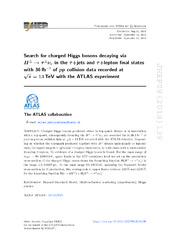Search for charged Higgs bosons decaying via H± → τ±ντ in the τ+jets and τ+lepton final states with 36 fb−1 of pp collision data recorded at √s=13 TeV with the ATLAS experiment
Aaboud, Morad; Aad, Georges; Abbott, Brad; Abdinov, Ovsat Bahram oglu; Abeloos, Baptiste; Abhayasinghe, Deshan Kavishka; Abidi, Syed Haider; AbouZeid, Hass; Abraham, Nadine L.; Abramowicz, Halina; Buanes, Trygve; Eigen, Gerald; Fomin, Nikolai; Lipniacka, Anna; Martin dit Latour, Bertrand; Mæland, Steffen; Stugu, Bjarne; Yang, Zongchang; Zalieckas, Justas; Bugge, Magnar Kopangen; Cameron, David Gordon; Catmore, James Richard; Feigl, Simon; Franconi, Laura; Garonne, Vincent; Gramstad, Eirik; Hellesund, Simen; Morisbak, Vanja; Oppen, Henrik; Ould-Saada, Farid; Pedersen, Maiken; Read, Alexander Lincoln; Røhne, Ole Myren; Sandaker, Heidi; Serfon, Cédric; Stapnes, Steinar; Vadla, Knut Oddvar Høie; Abreu, Henso; Abulaiti, Yiming; Acharya, Bobby S.; Adachi, Shunsuke; Adamczyk, Leszek; Adelman, Jareed; Adersberger, Michael; Adigüzel, Aytül; Adye, Tim; Affolder, Anthony Allen; Afik, Yoav; Agheorghiesei, Catalin; Aguilar Saavedra, Juan Antonio; ATLAS, Collaboration
Peer reviewed, Journal article
Published version

View/
Date
2018-09Metadata
Show full item recordCollections
Original version
https://doi.org/10.1007/jhep09(2018)139Abstract
Charged Higgs bosons produced either in top-quark decays or in association with a top-quark, subsequently decaying via H± → τ±ντ, are searched for in 36.1 fb−1 of proton-proton collision data at s√=13s=13 TeV recorded with the ATLAS detector. Depending on whether the top-quark produced together with H± decays hadronically or leptonically, the search targets τ+jets and τ+lepton final states, in both cases with a hadronically decaying τ-lepton. No evidence of a charged Higgs boson is found. For the mass range of mH±mH± = 90–2000 GeV, upper limits at the 95% confidence level are set on the production cross-section of the charged Higgs boson times the branching fraction B(H±→τ±ντ)B(H±→τ±ντ) in the range 4.2–0.0025 pb. In the mass range 90–160 GeV, assuming the Standard Model cross-section for tt¯tt¯ production, this corresponds to upper limits between 0.25% and 0.031% for the branching fraction B(t→bH±)×B(H±→τ±ντ)B(t→bH±)×B(H±→τ±ντ).
